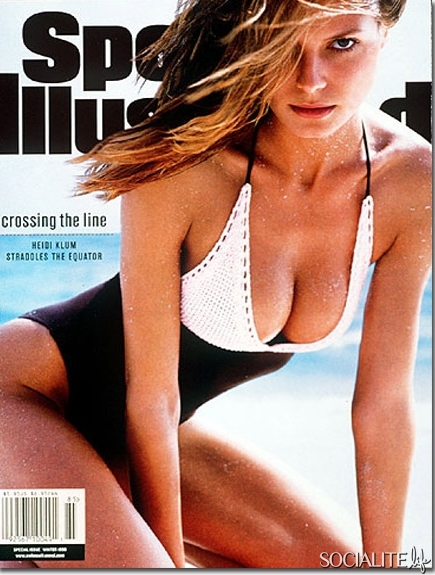A psychoanalytic approach to examining Sports
Illustrated swimsuit issue covers has the most potential of being the most helpful way
of understanding what the message of the cover is trying to get across to the viewer. As I
mentioned before, Rose says psychoanalysis, "consists of a range of theories that deal
most centrally with human subjectivity, sexuality, and the unconscious (Rose 149)." Within
a psychoanalytic analysis there are several types of theories that come into the picture
such as scopophilia, male gaze, phallocentrism, and subjectivity. The male gaze is of
utmost importance because, "The 'ideology of the male gaze' therefore refers to the
situation in which sportswomen are framed as objects of the male reader's gaze; in other
words, they are construed subjectively, according to stereotyped cognitions (mental
schemata) which harmonise with the expectations of the male reader (Brandt and Carstens
235)." After looking at the images that grace the cover of Sports Illustrated
swimsuit issues, the reader will then be able to identify and understand why the
supermodels take on certain poses and attitudes resulting in certain reactions and
attitudes taken by the audience looking at the magazine.
Sports Illustrated swimsuit issue offers beautiful, gorgeous, attractive, and sexy
women to the viewer by representing the women on the cover of the magazine in swimwear,
usually in a seductive bikini. "If women are depicted, they are portrayed in feminine
stereotypical roles (Wigmore, 1996), emphasizing beautifully proportionate and conditioned
bodies, posing in an erotic or sexually available way (Brandt and Carstens 233)."
Therefore the cover of the magazine is eye catching for anyone that comes across this
magazine, sometimes so eye catching that people can't keep their hands off the magazine,
especially men. Everyone in our society gains pleasure in looking, also known as
scopophilia. After looking at the cover I think that is might be nearly impossible for
someone to not gain pleasure from looking at one of these beautiful women on the cover of
the magazine. These supermodels and athletes have what our culture believes to be the
"perfect" body, they are tan, have long legs, and are curvy in all the right places. This
leaves the viewer with a sense of desire, whether it is man or woman that is looking at
the magazine cover. Women are left desiring the woman for many reasons. Women desire the
supermodels on the cover of the magazine because they want to be able to reach and attain
this so called "perfect" body that all of these women have. "References to the male gaze
derive undoubtedly from a heteronormative perspective, where it is assumed that all women
want to appear desirable to men (Jaworski, 2003)(Pienaar and Bekker 439)." The man, who is
interpellated by the seductively attractive women on the cover, desires this type of
woman. However, the man wants to have and desire the woman who has the "perfect" body and
knows how to be seductive and beautiful. That way when he has this unattainable woman he
knows that he has what our culture thinks is the most attractive woman by his side. Men
can't keep their eyes off the women on the magazine, which therefore brings in male gaze.
"The use of the term male gaze here is consonant with Laura Mulvey's (1975) original use
of her term to describe the gendered roles of male spectator and female sexual object... it
implies that men traditionally adopt the role of spectator, gazing at and appraising women
as erotic objects (Pienaar and Bekker 439)."
Brandt, Mandie, and Adelia Carstens. "The Discourse Of The Male Gaze: A Critical Analysis
Of The Feature Section 'The Beauty Of Sport' In SA Sports Illustrated." Southern African
Linguistics & Applied Language Studies 23.3 (2005): 233-243. Communication & Mass Media
Complete. Web. 8 May 2013.
Malkin, Amy R., Kimberlie Wornian, and Joan C. Chrisler. "Women and Weight: Gendered
Messages on Magazine Covers." Sex Roles 40.7-8 (n.d.): 647-55. Print.
Monk-Turner, Elizabeth; et al. "Who is gazing at whom> A look at how sex is used in
magazine advertisemesnt." Journal of Gender Studies 17.3 (2008). 201-209. Web.
Pienaar, Kiran, and Ian Bekker. "Invoking The Feminine Physical Ideal: Bitch-Slapping,
She-Men And Butch Girls." Southern African Linguistics & Applied Language Studies 24.4
(2006): 437-447. Communication & Mass Media Complete. Web. 8 May 2013.
Reichert, Tom. "The Ageless Allure: Sex, Media, And Marketing." Journal Of Promotion
Management 13.1/2 (2007): 3. Communication & Mass Media Complete. Web. 8 May 2013.
Rose, Gillian. Visual Methodologies: An Introduction to Researching with Visual Materials.
London: SAGE, 2012. Print.



